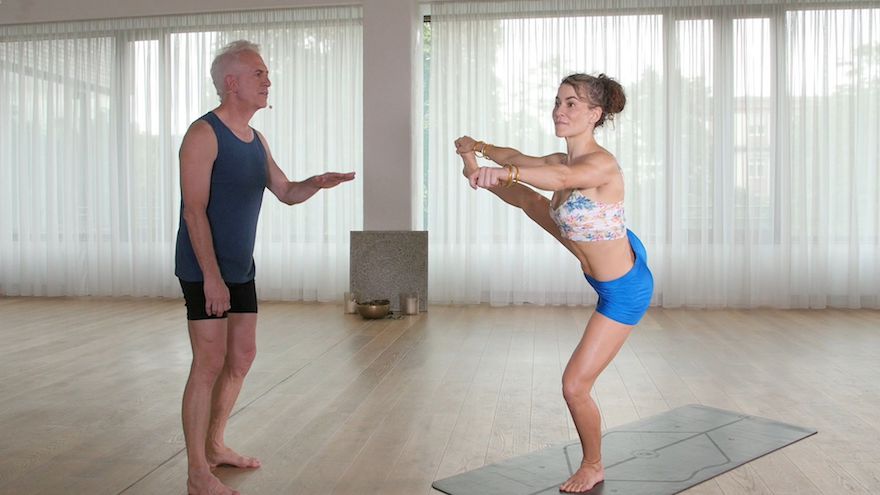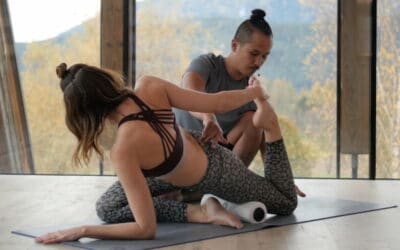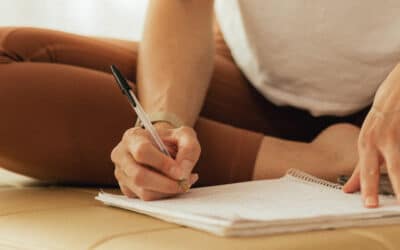How can you practice yoga at home? That is a very common question yoga students have. At first, it’s not that hard as it may seem. But everything is a bit of a struggle in the beginning – especially to find the motivation for rolling out the mat at home is often the most difficult part.
However, those who can practice yoga for themselves, learn a completely different facet of yoga and also of themselves.
Table of Contents
But before you bounce on the mat, it is advisable to have some yoga classes in advance. Because this is how you learn the right technique or get tips and tricks with what you should pay attention to in your practice and alignment. You get a good feeling for your practice and hopefully some constructive feedback under supervision.
The next step would be to create the ideal space for your yoga practice at home. Most of you won’t be able to spare an entire room for your yoga practice (which would be the perfect solution). However, make sure that it’s a space where you feel warm and comfortable and can be undisturbed for at least an hour.
You regularly attend yoga classes and found the perfect spot to roll out your yoga mat at home? Then nothing stands in the way of your home yoga practice.
1. Dare Yourself
To practice yoga alone, you just have to start. Sounds totally banal, but it is just like that. Anyone who always looks for excuses or persuades himself not to be “good” enough will never start. You know your body best, you just have to start listening to it.
And if it helps you get started, just record yourself while practicing. Not with the intention to post it on Instagram instantly, but to review your own practice and alignment afterwards. If you’re struggling with a pose, this is a good way to analyze where the mistakes are – it’s a common practice in sports science, so why not using it in yoga?
2. Make Your Own Routine
Each teacher and practitioner has just found his or her yoga routine over time. Some always or often start with the same exercises. And that’s good! It not only gives you security, but also helps to arrive on your mat on days when you’re completely lost in your thoughts. Because the body knows then what it has to do and guides you through your practice.
For beginners it is especially recommended to practice the Sun Salutation A and/or B. So you have a solid set of exercises that you can expand at any time as you feel more secure.

You can start your at home yoga practice with TINT, for example. Photograph by TINT.
3. Think About Your Practice
Think about which focus you want to set before you go on your mat or while doing the first sun salutations. Would you rather stretch the back of your body or the front? Maybe you prefer to practice a few balance postures?
Ask yourself these questions and then think about what exercises could fit in or ask google. Maybe you also have a pose that you would like to practice. Then find out exercises that prepare the muscles best for this pose.
4. Sequencing
Every good yoga class follows a certain structure. Start slow, breathe and move your body. This can be done sitting, lying, standing or in a down dog. From there start to get more intensity to your practice and bring the heat in your body and muscles. A few sun salutations are doing their job quite good.
Now you’re ready to approach your peak pose – the pose that describes the focus of your lesson. In backbends, this can be the wheel, for example, or Crow pose in arm balances. After your peak pose, it gets softer, long stretches and finally some compensation for the spine like small twists.
Then comes what everyone is looking forward to most in yoga: Savasana. Here it may be advisable to set an alarm clock just to prevent yourself from falling asleep – because you do not have a teacher to get you out of this.
5. Use Other Sources
There are now countless YouTube videos, online yoga studios and books to help you practice on your own outside of a yoga studio. You can, for example, use books, such as Yoga Workouts designed by Mark Stephens. Another great source for your home practice is our platform TINT where you can train with the world’s greatest yoga teachers. This will ensure that your practice is not only safe and healthy but also as effective as possible.
Desirée Rumbaugh and Andrew Rivin, for example, share their experiences and guide you through your home practice with Building Blocks for a Transformational Home Practice on TINT. This plan provides guidance on a wide variety of different yoga poses including standing poses, backbends, hip openers, inversions and arm balances.
Why not try practicing at home with Desirée Rumbaugh and Andrew Rivin on TINT?
If you’re completely new to yoga, you can also start out with Matt Giordano’s Yoga for Non-Yogis – which you can access for free on TINT.
Practicing yoga at home is wonderful and a great addition to your yoga practice, but a visit to your favorite teacher simply can not replace it. In the ideal case you will be well guided, adjusted and if you are lucky you will end up with a small massage.
At home, you can make yourself comfortable, find your own pace, listen to your body even better, and not be distracted by a look at the neighbors mat.
Have a wonderful yoga practice and as always in yoga: Listen to your body and let your ego outside the door. You can take it back afterwards if you absolutely need it.





